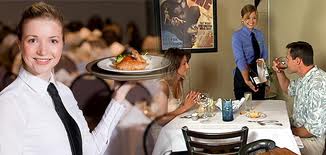INTRODUCTION:
Food and beverage serving and related workers are the front line of customer service in restaurants, coffee shops, and other food service establishments. These workers greet customers, escort them to seats and hand them menus, take food and drink orders, and serve food and beverages. They also answer questions, explain menu items and specials, and keep tables and dining areas clean and set for new diners. Most work as part of a team, helping coworkers to improve workflow and customer service. Hotel or Inn is defined by British law as “a place where a benefited traveler can receive food and shelter, provided him in a position to pay for it and is in a fit condition to be received.” Hence, a hotel must provide food and beverage and lodging to travelers on payment and has in turn, the right to refuse if the traveler is drunk, disorderly, unkempt or is not in a position to pay for the service. Eating away from home is generally increasing and there is widening diversity in the nature and type of food and beverage on offer. Because of the expansion of the industry and increasing Pressure for improved professionalism in food and beverage service staff, there is even greater need for more people to make their careers in this noble profession alongside the need for more people to make their careers in this noble profession alongside the need for improved confidence and performance through higher standards of knowledge and skills.Food and beverage service is the essential link between the menu beverages and other services on offer in an establishment and the customers. The server is the main point of contact between the customers and the establishment It is an important role in a profession which increasing national and international status. The skills and knowledge of food and beverage service and therefore careers, are transferable between establishments, sectors and through out the world. The hotel industry is perhaps one of the oldest commercial endeavors in the world. The first inns go back to The sixth century B.C. and were the product of the
urge to travel, spurred by invention of the ‘wheel’. The earliest Inns where ventures by husband and wife teams who provided large halls for travelers to make their own beds and sleep / take rest on the floor. They are also provided modest whole some food, thirst quenchers like wine, port, ale, etc. and stabling facilities.
To be successful in food and beverage service requires the blending of four key things:
1. SOUND PRODUCT KNOWLEDGE.
2. WELL DEVELOP IN INTERPERSONAL SKILLS
3. A RAGE OF TECHNICAL SKILL
4. THE ABILITY TO WORK AS PART OF A TEAM
Working in food and beverage service offers a wealth of opportunity for professional development and advancement for those committed to the hospitality industry and to working in food and beverage service, a fulfilling. exciting and enjoyable career awaits.
The industry provides millions of meals a day in a wide variety of types of food service operation. Some examples of the type of operation are given under; The food and beverage service department of a hotel is the most labor Intensive department.
The food and beverage service department is one of the major revenue producing areas, which includes right from the preparation of food to service of food and beverage service department is the busiest department in the hotel. The food and beverage service department comes under Food & Beverage Manage
TYPES OF SERVICE:
English Service:
Often referred to as the “Host Service” because the host plays an active role in the service. Food is brought on platters by the waiter and is shown to the host for approval. The waiter then places the platters on the tables. The host either portions the food into the guest plates directly or portions the food and allows the waiter to serve. For replenishment of guest food the waiter may then take the dishes around for guests to help themselves or be served by the waiter.
French Services:
It is a very personalized service. Food is brought from the kitchen in dishes and salvers, which are placed directly on the table. The plates are kept near the dish and the guests help themselves.
Silver Service:
The table is set for hors d’oeuvres, soup, main courses and sweet dish in sterling silverware. The food is portioned into silver platters at the kitchen itself, which are placed at the
sideboard with burners or hot plates to keep the food warm in the restaurant. Plates are placed before the guest. The waiter then picks the platter from the hot plate and presents the dish to the host for approval. He serves each guest using a service spoon and fork. All food is presented in silver dishes with elaborate dressing.
American Service:
The American service is a pre-plated service, which means that the food is served into the guest’s plate in the kitchen itself and brought to the guest. The kitchen predetermines the portion and the accompaniments served with the dish balance the entire presentation in terms of nutrition and color. This type of service is commonly used in a coffee shop where service is required to be fast.
Cafeteria Service:
This service exists normally in industrial canteens, colleges, hospitals or hotel cafeterias. To facilitate quick service, the menu is fixed and is displayed on large boards. The guest
May have to buy coupons in advance, present them to the counter waiter who then serves the desired item. Sometimes food is displayed behind the counter and the guests may indicate their choice to the counter attendant. The food is served pre-plated and the cutlery is handed directly to the guest. Guests may then sit at tables and chairs provided by the establishment. Sometimes high tables are provided where guests can stand and eat.
Counter Service: (Snack-bar Service)
Tall stools are placed along a counter so that the guest may eat the food at the counter itself. In better establishments, the covers are laid out on the counter itself. Food is either displayed behind the counter for the guests to choose from, or is listed on a menu card or common black board.
Grill Room Service:
In this form of service various meats are grilled in front of the guest. The meats may be displayed behind a glass partition or well decorated counter so that the guest can select his exact cut of meat. The food comes pre-plated.
Room Service:
It implies serving of food and beverage in guest rooms of hotels. Small orders are served in trays. Major means are taken to the room on trolleys. The guest places his order with the room service order taker. The waiter receives the order and transmits the same to the kitchen. In the meanwhile he prepares his tray or trolley. He then goes to the cashier to have a cheque prepared to take along with the food order
For the guests’ signature or payment. Usually clearance of soiled dishes from the room is done after half an hour or an hour. However, the guest can telephone Room Service for the clearance as and when he has finished with the meal.
There are two types of Room Service:
Centralized: Here al the food orders are processed from the main kitchen and sent to the rooms by a common team of waiters.
Decentralized: Each floor or a set of floor may have separate pantries to service them. Orders are taken at a central point by order-takers who in turn convey the order to the respective pantry.
Buffet Service:
A self-service where food is displayed on tables. The guest takes his plate from a stack at the end of each table or requests the waiter behind the buffet table to serve him.
For sit-down buffet service, tables are laid with crockery and cutlery as in a restaurant. The guest may serve himself at the buffet table and return to eat at the guest table laid out. The waiter may serve a few courses like the appetizer and soup at the table.
Russian Service:
An elaborate silver service much on the lines of French service except that the food is portioned and carved by the waiter at the gueridon trolley in the restaurant in full view of the guests. Display and presentation are a major part of this service. The principle involved is to have whole joints, poultry, game and fish elaborately dressed and garnished, presented to guests and carved and portioned by the waiter.
Gueridon Service:
This is a service where a dish comes partially prepared from the kitchen to be completed in the restaurant by the waiter or, when a complete meal is cooked at the table-side in the restaurant. The cooking is done on a gueridon trolley which is a mobile trolley with a gas cylinder and burners. The waiter plays a prominent part, as he is required to fillet, carve,
flambé and prepare the food with showmanship. The waiter has to have considerable dexterity and skill.
Breakfast SERVICES:
There are basically two types of breakfast offered in hotels and restaurants, Continental breakfast and English breakfast. The Continental Breakfast originated in Europe.
Light meal as the Europeans normally have a heavy mid-day meal. The English breakfast is heavy and is a major meal of the day. A traditional English breakfast runs into six or seven courses.
Principles of Food & beverage SERVICES
There are some basic principles in food and beverage service that a waiter must know:
When the waiter at the table serves food from a platter onto a guest plate, the service is done from the left.
When food is pre-plated the service to the guest is usually done from the right, though modern convention permits service from the left also.
All beverages are served from the right.
Ladies are always served first and the remaining guests clockwise. Soiled plates should always be cleared from the table from the right. Empty crockery and fresh cutlery are always served from the right. Never reach across a Customer. Hence, when a guest is present at the table, all items and equipment on the right of guest must be placed from the right and that on the left from the left.
















